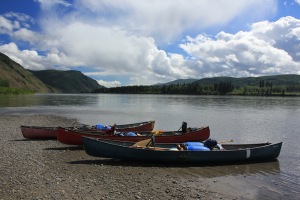
The first from our ‘Top Ten Tips” series – lessons from the road (and river!) that we hope will make adventuring with your kids all the more likely, and fun!
This time – Top Ten Tips for canoe-tripping with kids:
- Start them early. We started paddling with our kids when they were babies – you can’t strap them into a car seat or even put a sling in a canoe since they need to be able to float up to the surface if the canoe bails, so we started with them in a life jacket on our laps, and we’d lay them down with an umbrella over them for shade if they fell asleep in the boat (as babes tend to do!). We went for our first overnight canoe trip when they were 1 and 3, and for our first epic Yukon River trip at ages 2 and 4. By that time they were used to the concept of sitting in a canoe (without jumping out or rocking the boat), and they knew how to paddle, which brings me to #2
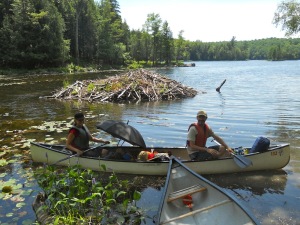
- Buy kid-sized paddles, with cords to attach them to their life jackets. Even if they don’t paddle all the time (or paddle more backwards than forwards), it makes canoeing far more entertaining for them – without the frustration of losing paddles downstream.
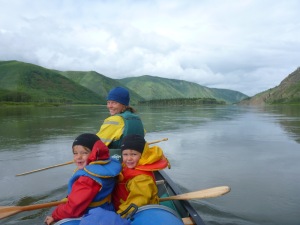
- Bring buckets and collect sticks. At each stop point the kids can load their bucket full of collected rocks to throw randomly into the river, and long sticks for pretend fishing. Nature provides plenty of toys that you won’t mind losing in the river, so save the toys you would mind losing in the river for camp time.
- Invest in a good dehydrator and water filter, and focus on energy-packed foods. We bought a 9-tray Excalibur to dehydrate our family’s favourite one-pot meals for suppers, which decreases cost, weight, prep time and the stress of packing and keeping fresh dinner ingredients, while ensuring nutritious and energy-replenishing meals. We also brought pre-packaged breakfasts (oatmeal with nuts, coconut, raisins and hemp seeds for energy-packed toppings) and plentiful, light all-day snacks like dehydrated protein bars, dehydrated veggie pate, dried fruit, nuts and one daily ReBar each (8 servings of fruit and veggies per bar!). Did we mention energy foods are important? Finally, a good water filter is a must for your health on the river. On our second trip we sprung for a gravity bag filter, which is considerably faster and easier than a hand pump – you can even filter as you paddle! Make sure everyone drinks at least two litres of straight-up filtered water a day by filling bottles regularly and having them readily available in the boat.
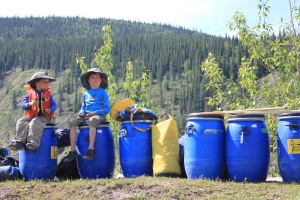
- Plan your day wisely. Nothing ruins a happy family vacation more than stressing out about time. Plan for shorter distances and fewer paddling hours than you would if traveling without your kids, and enjoy the sights and the relaxed pace that much more! We paddled about four hours a day from ages 2 to 6, but you’ll know how much time your kids can handle, so plan accordingly and err on the side of less time stress! Allow plenty of time for on-shore stretch breaks (see #6) that your kids will need much more than you think, and will last longer than you plan. The last things you want are overly rushed breakfasts or late arrivals at camp and frantic dinner prep. But also don’t mosey too much – there’s a lot to do in the mornings and evenings, including water filtering, packing and unpacking, and having time to unwind as a family. It’s also a good idea to keep your bedtimes on track – it can be so tempting to stay up late, push back dinner and have campfires every night together, but your kids (and you) will suffer from lack of sleep in the long run (especially if your canoe trip is longer than a weekend). Besides, putting the kids to bed on time leaves time for a glass of wine for the adults by the river!
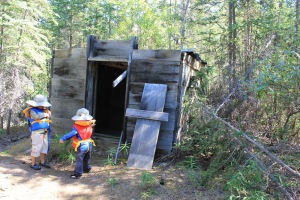
- Use breaks for fun and exercise, not for eating. No matter how much fun you have in the boat, your kids aren’t getting their required run-around-and-frolic time. We aim for on-shore breaks every hour or two, lasting at least half the time paddled (half-hour for every hour in the boat). And don’t make your kids sit and eat on shore! Snacking in the canoe is a great way to pass the time, so save the on-shore breaks for exploring, running around, playing and going to the bathroom. Oh yeah, keep a full roll of toilet paper in a Ziploc bag handy at all times!
- Get the kids psyched about the trip beforehand and afterward. Read with your kids about where you’re going, look at maps and watch videos in the weeks before departure. Encourage them to envision the upcoming adventure and predict the kinds of animals and other sights they’ll see. While on the river, have the kids keep a journal – even just writing down what wildlife they saw every day and their favourite part of each day – so they can remember it afterwards and show their friends and grandparents. And back to the issue of bathroom breaks, make sure to play up how fun it is to poop outdoors, in order to avoid your kids getting stage-fright and holding it in for days!
- Be prepared for emergencies. You’ll stress less and enjoy more if you’ve fully covered all your bases. Make sure everything that needs to be waterproof is waterproof, and tie all the gear down in the boat in the event of a flip. Carry a full first aid kit and know how to use it, and invest in Medevac insurance (MEC members may get a discount with The Co-operators) and a satellite phone if you are in the wild. Have a plan about what to do if someone falls overboard (don’t jump in after them and risk tipping the whole boat, but instead throw them the bailing bucket on a rope to reel them in), if you encounter a bear or other wildlife encounters (black vs grizzly, get big and loud vs play dead), and review the plans together once a day. Be bear aware by storing food properly (no scraps left out, dishes clean, all food in bear barrels, no food or scents in tent) and carry bear spray at all times – that means no kids wandering without an adult with spray. Finally but still very importantly, carry proper rain gear so everyone can be fully waterproof when needed, wear the most quick-dry clothes you have, and keep a stock of always-dry warm cozy clothes for everyone in the event of a prolonged rain.
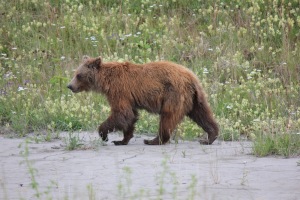
- Give the kids jobs to do at camp. Kids love being part of the team and involved in everything. This will probably slow you down at first, but it pays off in the long run as they become expert and enthusiastic tent-builders, air-mattress-inflaters, sleeping-bag-packers, kindling-collectors and dish-cleaners. Our kids even learned to help put in, take out, and tie up the canoes, and to pump river water through a filter. They’ll feel much more ownership over the trip and appreciate all the effort it takes to make it happen.
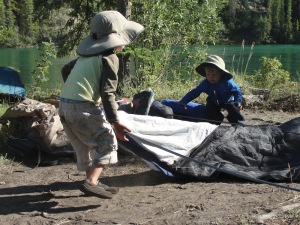
- Travel with other adults/families. We have yet to do a canoe trip without friends or family – having more adults to pitch in is a huge bonus. It also means that the kids can have a variety of paddling partners – we had one canoe that the boys’ boat (they sat in the middle side-by-side, with one adult at front, one at back) and the adults all swapped places so everyone got turns with everybody. This way, the boys got fresh stories, games and variations of ‘I-spy’ after every switch up!
